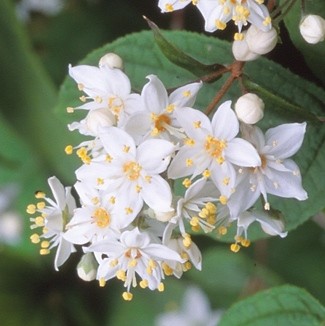Fuzzy Pride-Of-Rochester
(Deutzia crenata heterotricha)

Description
Deutzia scabra is a species of flowering plant in the hydrangea family (Hydrangeaceae) native to Japan and introduced to mainland east Asia, Europe, and North America. In its native Japan, it is found from the Kantō region, westward to the islands of Kyushu and Shikoku.Its natural habitat is along forest edges and rocky openings.It is tolerant of disturbance and can be found growing out of stone walls, along roadsides, and in other waste areas. Deutzia scabra is a deciduous shrub growing 1-2 meters in height. One way it differs from other Deutzia of Japan, is by its somewhat dimorphic leaves: those subtending the inflorescence being sessile and slightly clasping, while leaves lower down the stem are petiolate.It produces panicles of white flowers, blooming from May to July. The cultivar 'Candidissima' bears double flowers, and is taller than the species at up to 4 m (13 ft). It is a recipient of the Royal Horticultural Society's Award of Garden Merit. The pink flowered double 'Codsall Pink' has also received the award. Deutzia (/ˈdjuːtsiə/ or /ˈdɔɪtsiə/) is a genus of about 60 species of flowering plants in the family Hydrangeaceae, native to eastern and central Asia (from the Himalayas east to Japan and the Philippines), and Central America and also Europe. By far the highest species diversity is in China, where 50 species occur. The species are shrubs ranging from 1–4 m (3 ft 3 in – 13 ft 1 in) in height. Most are deciduous, but a few subtropical species are evergreen. The leaves are opposite, simple, with a serrated margin. The flowers are produced in panicles or corymbs; they are white in most species, sometimes pink or reddish. The fruit is a dry capsule containing numerous small seeds. Identification of the species is very difficult, requiring often microscopic detail of the leaf hairs and seed capsule structure. Deutzia is named after the 18th century Dutch patron of botany, Johan van der Deutz. The deutzias are fairly new to gardens: the exception, D. scabra, was noticed in Japanese gardens by Engelbert Kaempfer (1712) and Carl Peter Thunberg (1784) but not actually seen in Europe till the 1830s; two-thirds of the species noted in the R.H.S. Dictionary were gathered in from the wild during the 20th century.
Taxonomic tree:







